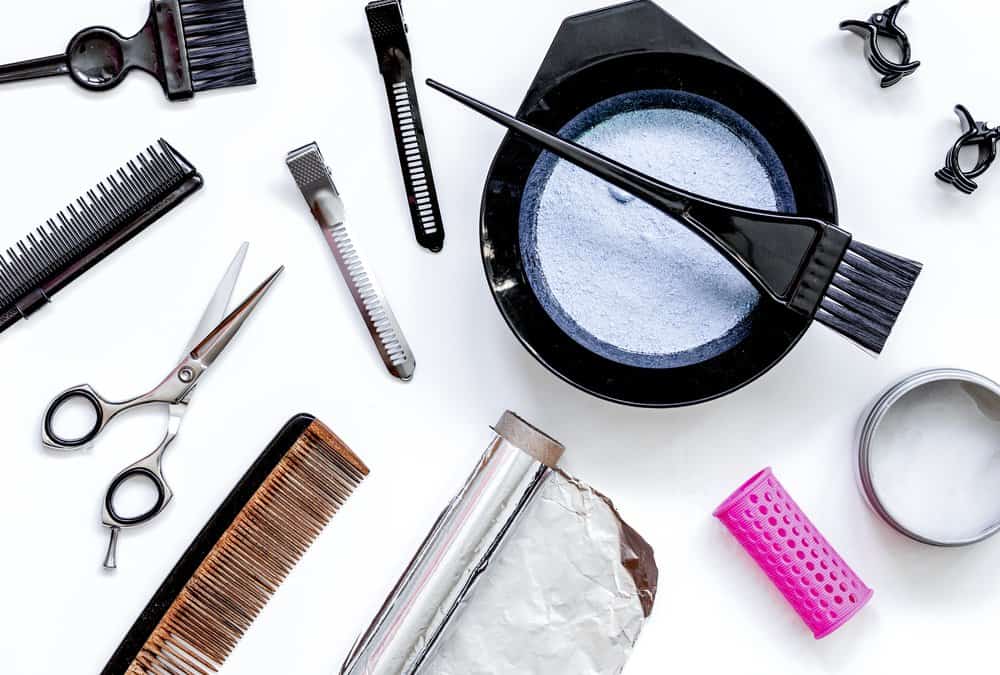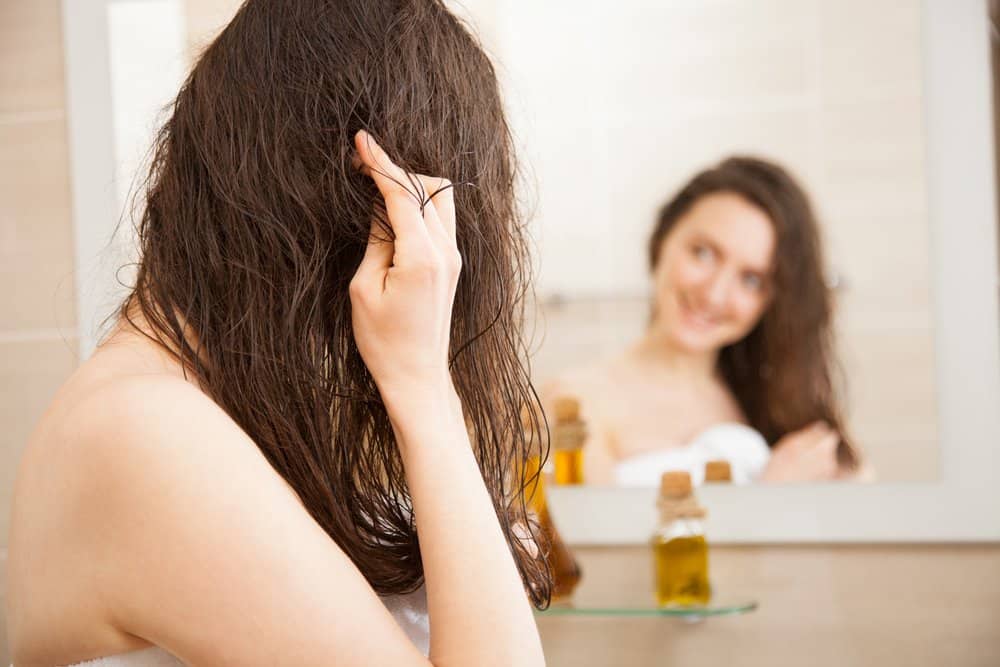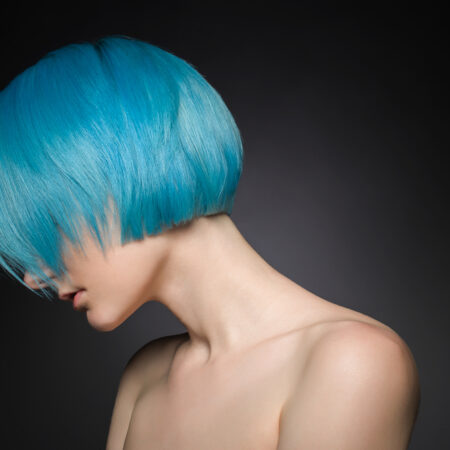Even though it can look fantastic on first application, blue hair dye can be one of the most stubborn colors to remove from your tresses, especially as it fades out and becomes a shadow of its former bright blue glory. Attempts to remove and/or lighten blue hair dye can sometimes fall flat, so that’s why we’ve decided to help you out!
In this article, we will be discussing the best ways to completely remove blue hair dye from your hair. We’ll also be discussing the easiest way to get blue hair dye off your skin and what you can do to care for your hair after the blue dye has faded from it.
Why Blue Hair Dye Is So Hard to Remove
Whether you’re a new user of blue hair dye or have used it regularly over the years, you may have come to the realization that it is one of the hardest colors to remove. The reason behind this is that blue dye is a dark, very heavily pigmented color; the chemicals that comprise blue hair dye have to be this way to get the dye to show up vibrantly on your locks.
In fact, blue hair dye is often regarded as a stain, meaning that it will color and stain your hair, but it will also stain everything else, including your skin, scalp, and bathroom counters.
Your blue hair dye may naturally fade to a lighter blue or greenish color depending on what undertones the dye and your original hair color have, but completely removing the blue dye may take some heavy-duty effort before you arrive at your desired hair color.
Best Methods for Removing Blue Hair Dye
The below methods are the most effective at removing blue hair dye. Keep in mind that many of these can be drying or damaging to hair, so make sure you understand each method fully before using it and ensure that you take proper care of your hair during and after the dye removal process.

Color Remover
A good first step to take in removing blue hair dye is to apply a color remover. Products like Color Oops can help to strip pigment out of the hair, lightening the blue color and helping to return your locks back to their original color.
However, color removers can be very hit or miss on blue hair dye and may not work on your first try. If the color isn’t lightened enough after one use, wait a few days and then try again, as color remover can be very drying to your hair, and overuse might cause damage.
Clarifying Shampoo
Using a clarifying shampoo can take a while to fade the blue color, but it is a fairly foolproof way to lighten blue pigments in your hair. Clarifying shampoo opens the hair cuticle, allowing it to release any blue color held in there. Over time, this can create a lot of lightening in your hair; use the shampoo 2 to 3 times a week for best results.
Clarifying shampoos can also be very drying, so make sure to follow up with a conditioner each time you use one. We suggest using Head and Shoulders shampoo; this brand works surprisingly well to remove blue pigments from hair.
Bleach Bath
A heavy-duty method, a bleach bath is best used when you want a sure-fire way to remove pigment from your hair as quickly as possible.
Keep in mind that bleach in any form can be damaging to your hair, and while the bleach in a bleach bath is diluted, you should still take extra care to rehydrate and nourish your hair after use.
Bleach baths are also preferable to whole head bleaching when it comes to removing blue hair dye because they are easier to apply and run less of a risk of reacting with the chemicals in the dye, turning your hair an unwanted color.
Here’s how to bleach bath your hair.
- Mix bleach and a 30-volume developer in a mixing bowl at a 1-to-1 ratio.
- Add enough shampoo to equal the amount of bleach and developer combined, then mix all of the ingredients thoroughly.
- Apply the bleach mixture to wet hair, making sure to work from the ends of the hair up to the roots. You should try and work as quickly as possible to cover all of your hair, but be careful that you don’t miss spots, or the lightening effect will be patchy. Do not lather or scrub the bleach mixture harshly, as this can damage your scalp.
- Once the bleach bath has been applied, wait about 10 to 20 minutes before rinsing it off with warm water.
- If your hair is not light enough after one application, wait a few days and then try again. You shouldn’t apply a bleach bath more than once a day, as this runs a high risk of damaging your hair.
Baking Soda
Baking soda is a natural bleaching agent, and while it isn’t as harsh as bleach, it can still be a little bit drying to your hair. The best way to use baking soda to strip pigment is as follows.
- Mix 2 tablespoons of baking soda with some shampoo until it forms a smooth paste; you may need to add a little bit of water to the mixture to achieve this.
- From there, apply it to your hair in the shower and lather lightly. Don’t scrub it along your scalp, as this may irritate your skin.
- After you’ve coated your hair in the mixture, allow it to sit for a few minutes before rinsing it out with warm water.
- Follow up with a mixture of conditioner and a small amount (around 1 tablespoon) of vinegar. The vinegar will neutralize any remaining baking soda and will be undetectable when mixed in with the conditioner.
You can repeat this treatment once or twice a week until your hair is fully lightened, but be sure to alternate with conditioning and strengthening treatments, as baking soda can seriously dry out hair.
As an alternative to baking soda, you can use dish soap in exactly the same way. Just skip the vinegar rinse and be sure to thoroughly wash any remaining dish soap out of your hair, as it can be pretty drying to your locks.
Vitamin C Treatments
Similar to the baking soda remedy, adding vitamin C to your shampoo can be a great way to get rid of unwanted blue pigments. Vitamin C can also be a little healthier for your hair, as it doesn’t dry out the cuticles the way baking soda might.
For this method, do the following.
- Mix vitamin C powder with a small amount of shampoo.
- Apply the mixture onto damp hair, coating each strand thoroughly.
- Tie your hair up in a towel or a plastic bag and wait at least an hour with the mixture on your hair.
- After the time is up, rinse your hair out completely with warm water and then shampoo and condition regularly.
This article can give you a more detailed guide on using vitamin C in your hair.
Cancel the Color Out
On the color wheel, blue pigments sit directly across from orange ones. This means that using a red or copper-colored hair dye over a faded blue dye can eliminate all of those blue pigments.
Keep in mind that this method works best on blue hair that is already fairly faded but not completely removed from the hair, as too much blue dye may mix badly with the other dye you choose, leaving you with a strange new color.
Sun Exposure
The most natural and cheapest method on this list, fading your blue hair with sun exposure, also takes the most time. The sunlight naturally breaks down the bright blue pigments, lightening your hair over time.
Taking long walks in the summer sun (with proper skin sun protection, of course) or swimming in a pool are great ways to fade your blue hair. Plus, the chlorine in the pool can work to fade your blue hair with repeated exposure.
Caring for Your Hair After Dye Removal
Once you’ve succeeded in removing the blue pigment from your hair, your locks will likely be in need of some TLC. Follow our tips below to get your hair back into good shape.

Hydrating Your Locks
The most common side effect of removing hair dye with any of the methods listed is a dryness to your hair. By adding moisture back into your tresses in the form of oil treatments, nourishing hair masks, or deep conditioning treatments, you encourage the hair to repair itself. This can also make the hair much stronger and softer over time.
Strengthening Treatments
Strengthening treatments, like hair masks and Olaplex, can work to repair your hair from the inside out. These treatments work to repair cuticles, reversing signs of damage and leaving hair both soft and strong.
They are a great choice for improving your hair’s condition after dye removal or other harsh hair treatments, such as bleaching.
Preparing Your Hair for Another Dye
Once the blue pigments in your hair have faded enough or been completely removed, you can prepare your hair for another coloring treatment. It is a good idea to wait several weeks between dye jobs, as this will give your hair time to rest and repair itself, making it a good canvas for your next color.
If you choose to add a dye over faded blue hair, make sure to reference the color wheel for your particular dye’s undertones, as you don’t want the colors to mix poorly and leave you with an undesirable color. As we discussed above, the best dyes to use over faded blue hair are copper, reds, and orange-toned colors.
When to See a Professional About Blue Hair Dye Removal
If you are concerned about the state of your hair or not confident when it comes to removing your stubborn blue dye alone, you may want to consult a professional.
A stylist can help evaluate your hair and apply the best removal method with skill, lifting the blue color out of your hair without too much stress or damage. A professional may also be able to help remove any remaining blue hair dye that you’ve unsuccessfully tried to remove at home.
While consulting a professional may be a little costly, in many cases, it is much better to seek help instead of forging ahead and potentially running your hair. So, if you have any doubts at all about removing blue hair dye, you should go ahead and talk to someone at your nearest salon.
Removing Blue Hair Dye From Your Skin
Not only does blue hair dye stick around in your hair for a long time, but this highly pigmented dye can also be troublesome to remove from your skin.
When applying blue dye, we suggest that you protect your hairline and scalp with coconut oil; the oil will act as a barrier between your skin and the dye, preventing extreme staining.
If you already have dye stained on your skin, you can use a little bit of rubbing oil on a cotton pad to wipe off the dye. Make sure to wash the rubbing alcohol off of your skin completely after use, or your skin may be irritated. And if you don’t have rubbing alcohol at the ready, this article can help you figure out the best way to remove blue hair dye from your skin.
Fading Blue for a New Style
If you’ve fallen out of love with your bright blue look and want to try out a new style, you may be discouraged by how difficult it can be to remove blue hair dye from your hair.
However, with the help of one or more of the methods we’ve discussed, it is possible to remove all of the blue dye out of your hair, making way for a brand-new style. As long as you use patience and fully understand each method so as to not damage your hair, you’ll be fading your blue hair dye in no time at all.
